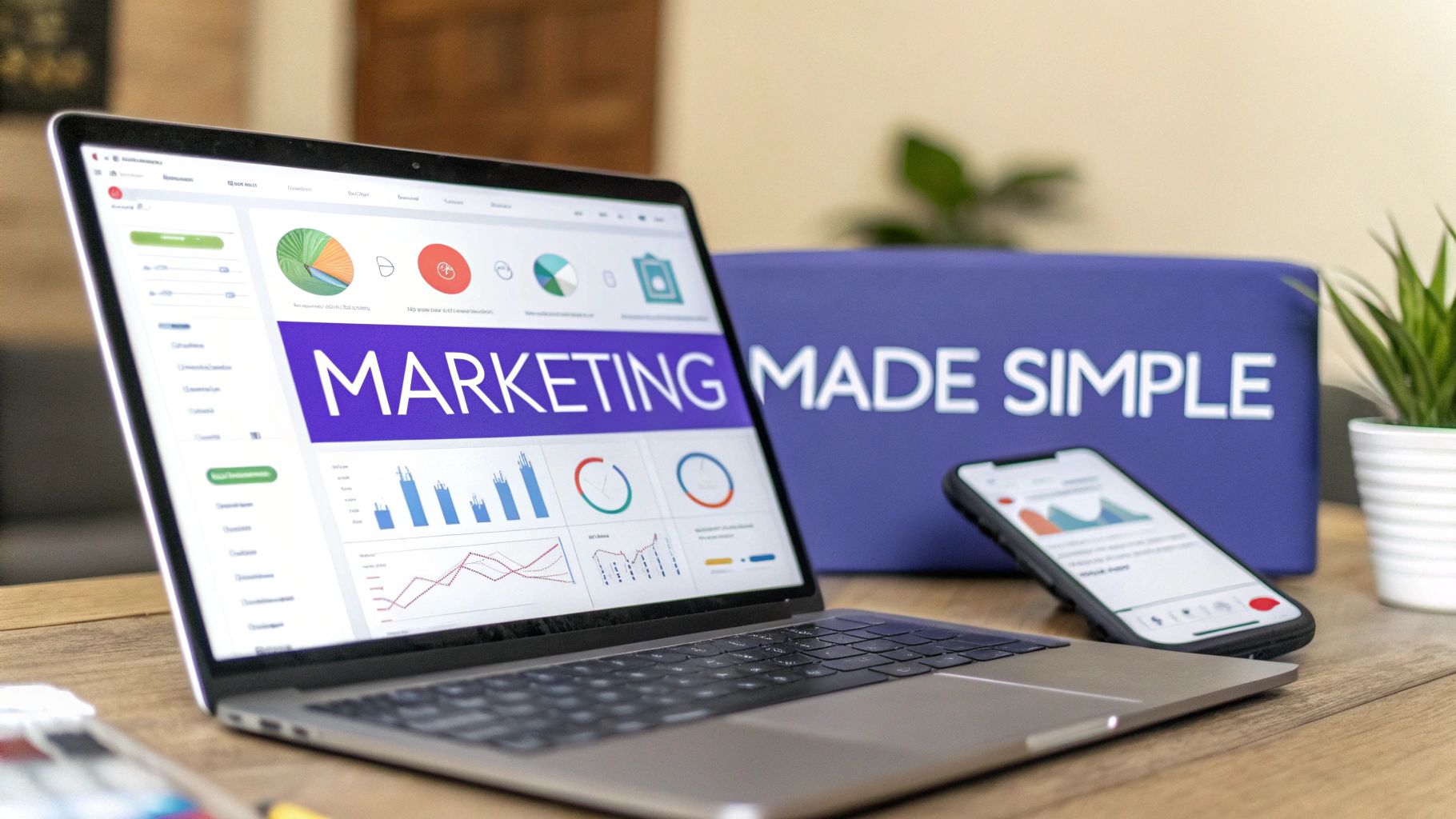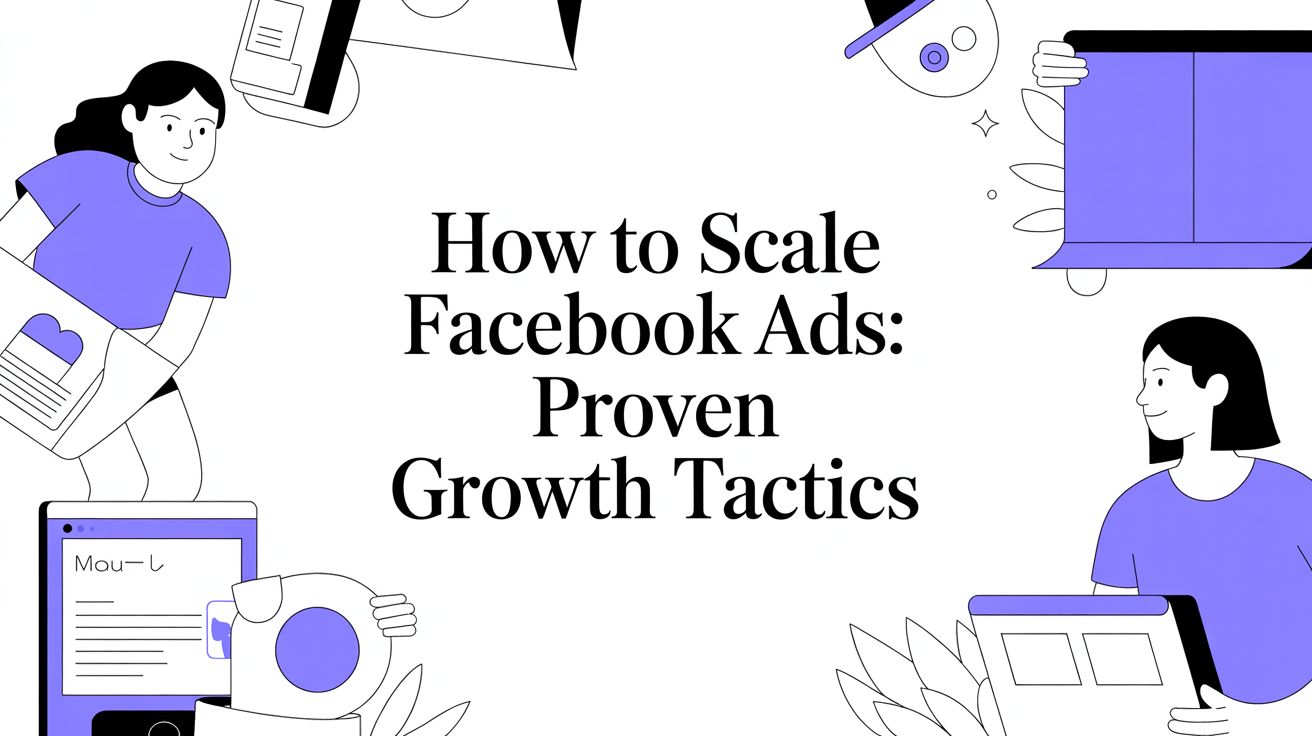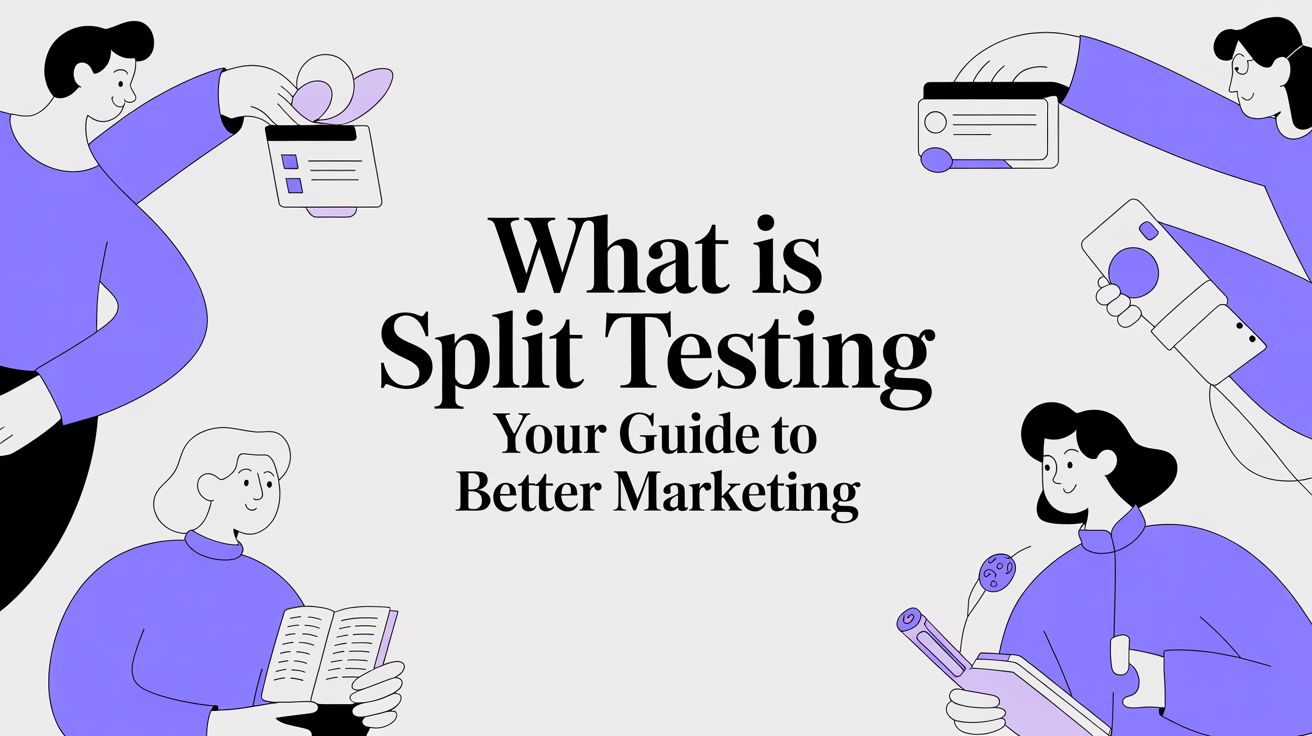For a startup, digital marketing isn't just a "nice-to-have"—it's the very lifeblood of your business. It's how you get your great idea in front of the right people, build awareness, and start bringing in customers, all without the massive budget traditional advertising demands.
Think of it as the difference between shouting into the wind and having a direct, personal conversation with someone who actually wants to hear from you. It’s your toolkit for turning a concept into a real, money-making company.
Why Digital Marketing Is Your Startup’s Growth Engine
Every penny and every hour is precious when you're just starting out. Old-school marketing methods, like print ads or billboards, are not only expensive but also notoriously difficult to measure. Did that ad actually bring in any customers? It's often a mystery.
Digital marketing flips that script. It offers a direct, data-rich path to connect with potential customers right where they hang out online. This guide is your blueprint for building a powerful growth engine, piece by piece. We'll skip the jargon and focus on a practical strategy designed for one thing: getting the biggest bang for your buck.
Our approach rests on three core pillars.
Pillar 1: Own Your Digital Real Estate
First things first, you need a home base that you control completely. This means your website and your email list. Social media platforms are great for reaching people, but their algorithms can change overnight. Your website and email list, however, are yours. They are the unshakable foundation of your brand and the primary channels for building lasting customer relationships.
Pillar 2: Engage Where It Counts
Don't fall into the trap of trying to be everywhere at once. It’s a surefire way to burn through your time and money. The key is to find the 2-3 channels where your ideal customers are most active and go all-in there. This focused approach is about working smarter, not harder.
You can learn more about finding the right voices on these channels in our guide on using AI for influencer marketing.
Pillar 3: Let Data Be Your Guide
Finally, and most importantly, you have to use data to make smart moves. Every click, every view, and every sale is a piece of feedback telling you what’s working and what’s not. By learning to pay attention to these signals, you can quickly pivot your strategy, putting more resources into your winners and cutting your losses. This ensures your budget is always working for you.
The goal isn't just to do marketing; it's to build a repeatable, scalable system that generates customers and revenue predictably. This is the difference between simply staying afloat and achieving rapid growth.
The world of digital marketing is massive—the global digital ad industry is expected to reach an incredible $1.16 trillion by 2030. Yet, despite this, a staggering 38% of companies still don't have a documented digital marketing strategy. This gap presents a huge opportunity for a nimble startup like yours to get ahead by building a solid framework from day one.
To help you get started, here’s a quick summary of the core pillars every startup should build its strategy around.
Core Pillars of Startup Digital Marketing
This table breaks down the essential strategic pillars that will help you build a strong digital marketing foundation.
| Pillar | Primary Goal | Key Channels |
|---|---|---|
| Owned Assets | Build a stable brand foundation and nurture long-term customer relationships. | Website, Blog, Email List |
| Strategic Engagement | Reach and connect with your target audience where they are most active. | Social Media, SEO, Content Marketing |
| Data-Driven Decisions | Optimize spending and strategy by measuring performance and focusing on what works. | Analytics Tools, A/B Testing, Conversion Tracking |
By focusing on these pillars, you aren’t just creating a marketing plan. You’re building a powerful and sustainable engine for growth.
Building Your Foundation with SEO and Content
If you think of your startup as a house, then Search Engine Optimization (SEO) and content are the foundation. You could try to build on shaky ground with quick fixes like paid ads, but for growth that lasts, you need to build on solid rock. That's what a great SEO and content plan gives you—an asset that keeps growing in value and works around the clock to bring the right customers to your door.
SEO is basically the blueprint for your house. It's how you make sure search engines like Google understand what your business does and who it's for. The content—your blog posts, guides, and videos—is the actual material you build with. When you put them together, they create a powerful engine for growth that runs on its own.
Getting Started with SEO (Without the Jargon)
SEO can sound super technical and intimidating, but for a startup, it really just comes down to three main things. You don't need to become an expert overnight. Just focus on nailing these fundamentals, and you'll be on the right track to getting found online.
- Keyword Research: This is all about figuring out the exact words and phrases your potential customers are typing into Google. It’s like listening in on their thoughts to understand what they’re struggling with and what they need. Tools like Google Keyword Planner or Ahrefs are great for this.
- On-Page SEO: This just means tweaking your individual web pages so they show up higher in search results. It’s about putting your main keywords in your page titles and headings, making sure your site loads fast, and ensuring it looks good on a phone.
- Building Authority: This is really about earning trust. Just like you'd trust a recommendation from a friend, Google trusts websites that other reputable sites link to. You earn these links by creating fantastic, shareable content that people genuinely want to reference.
By focusing on these three simple areas, you're making it much easier for your ideal customers to find you—without paying for every single click.
Creating Content That Actually Connects
Content marketing isn't about running ads; it's about becoming the go-to resource in your field. When someone has a problem, you want your content to be the solution they find.
This is where you get to tell a story. People don't fall in love with products; they connect with stories that solve their problems. A good blog post isn't just a dry list of features. It’s a helpful guide that walks someone through a challenge, making their life a little easier.
The best content marketing doesn't feel like marketing at all. It feels like a helpful conversation. You build a relationship by giving, giving, and giving value long before you ever ask for a sale. That's how you turn strangers into fans.
To really get that early traction and build a community, learning some proven content marketing tactics for startups is key to making authentic connections that last.
Your First Content Marketing Pieces
For a new startup, some types of content give you way more bang for your buck. These are the foundational pieces that will attract visitors, build your credibility, and bring in leads for years. I'd suggest starting with these:
- Pillar Blog Posts: These are massive, in-depth articles that cover a core topic in your industry from A to Z. Think of it as the ultimate guide that answers every question someone could possibly have on that subject.
- How-To Guides: Everyone loves a good how-to guide. They are super practical, solve an immediate problem, and get shared like crazy because they are genuinely useful.
- Case Studies: Nothing builds trust faster than proof. Case studies show exactly how your product helped real people get real results. They’re the ultimate "show, don't tell" for your business.
These aren't just blog posts filling up a page. They are your hardest-working assets, constantly attracting traffic, educating potential customers, and building the trust you need to turn a curious browser into a happy customer.
Choosing the Right Channels for Maximum Impact

When you're launching a startup, it feels like you need to be everywhere online—every social media platform, every new channel, all at once. But that’s a classic trap. Spreading yourself too thin is a surefire way to make a tiny ripple everywhere instead of a big splash somewhere meaningful.
Think of it like fishing. You wouldn't just throw a giant net into the ocean hoping to catch a specific fish. You'd figure out where that fish swims, what it eats, and then go to that exact spot with the right bait. Digital marketing is the same game. Your job is to find where your customers hang out online and meet them there.
Identify Your Ideal Customer
Before you spend a single dollar on an ad, you have to know exactly who you're talking to. This is where creating an Ideal Customer Profile (ICP) comes in, and it's the most critical first step you'll take. We're not just talking about basic demographics like age or location. You need to get inside their heads.
What are their biggest frustrations at work? What online forums or Slack communities do they live in? Which social platforms do they scroll through for advice versus pure entertainment? Answering these questions gives you a roadmap to their digital world. Once you have that map, you can zero in on the 2-3 high-impact channels where you can actually build a connection.
Don’t try to be everything to everyone. Your real goal is to become the absolute best solution for a very specific group of people. Winning as a startup means owning your niche.
Selecting Your Primary Channels
With a clear picture of your customer, you can start weighing your options. Let’s walk through a few powerful channels for startups that offer precise targeting and a solid chance at a good return.
Social Media Advertising
Platforms like Meta (Facebook and Instagram) and TikTok have incredibly granular targeting. You can reach people based on their interests, online behaviors, job titles—you name it. This makes them perfect for reaching a specific niche with visual, attention-grabbing content.
And it’s a growing space. The global social media ad market is expected to jump by 12% in 2025. This matters because 76% of social media users say what they see in their feeds influences what they buy. You can dig into more of this data over at Marketing Dive.
Influencer Marketing
Collaborating with creators who already have your target audience's trust is a powerful shortcut to building credibility. This isn’t about huge celebrity endorsements. It's about finding authentic voices who are respected in your specific niche.
There's a reason why over half (59%) of marketers are planning to spend more on influencer partnerships. It’s a way to borrow trust and get your product in front of an already-engaged community, fast.
Video and Connected TV (CTV)
Video isn't a "nice-to-have" anymore; it's what people expect. Short-form videos on TikTok and Instagram Reels are fantastic for quickly showing off your product's value in a way that’s easy to digest.
Beyond that, the growth of Connected TV (CTV) ads on streaming services like Hulu and YouTube TV is a game-changer. It lets you reach people in their living rooms with the impact of a TV commercial but with the precise targeting of a digital ad. If you're looking for inspiration, our guide on small business video marketing is packed with ideas to get you started.
Ultimately, the right mix depends entirely on your audience and your budget. A B2B software company will likely find its home on LinkedIn, while a new fashion brand will probably crush it on Instagram and TikTok. The key is to start small. Master one or two channels first, prove they work, and then you can expand your reach as you grow.
4. Smart Budgeting for Sustainable Growth
For any startup, your budget isn't just a number on a spreadsheet—it's your runway. How you manage it determines whether you achieve liftoff or run out of fuel mid-air. The good news is that effective digital marketing isn't about having the biggest budget. It's about having the smartest one.
Forget those rigid, old-school rules about dedicating a fixed percentage of revenue to marketing. A startup’s needs can change in a week. A much better approach is to think about your budget in phases, aligning your spending with your current stage of growth. This way, every single dollar is put to work where it can make the biggest difference right now.
Phase 1: The Foundational Budget
This is your starting line. The foundational budget covers the absolute must-haves for simply existing online. We're not talking about aggressive growth just yet. This is all about setting up your digital storefront and getting your basic toolkit in order.
Think of it like setting up a physical shop before your grand opening. You need to pay the rent and get the lights on. Your primary costs here will be things like:
- Website Hosting and Domain: The non-negotiable cost of your little corner of the internet.
- Essential Software: Subscriptions for an email marketing platform like Mailchimp, a simple CRM, or a social media scheduling tool.
- Core Content Creation: An initial investment to get your key website pages written or to produce a few foundational blog posts.
This phase is purely about building assets, not running expensive campaigns. The goal is to create a solid base you can build on later.
Phase 2: The Growth Budget
Once your foundation is solid, it’s time to unlock the doors and start inviting people in. The growth budget is where you begin spending money to actively acquire your first customers. This is where you get to dip your toes into paid advertising and content promotion.
This is your first real push into paid channels. For instance, you might earmark a small budget for an ad campaign on a single, well-targeted platform like Meta or LinkedIn. This initial spending is less about making sales and more about gathering priceless data on which messages and audiences actually click.
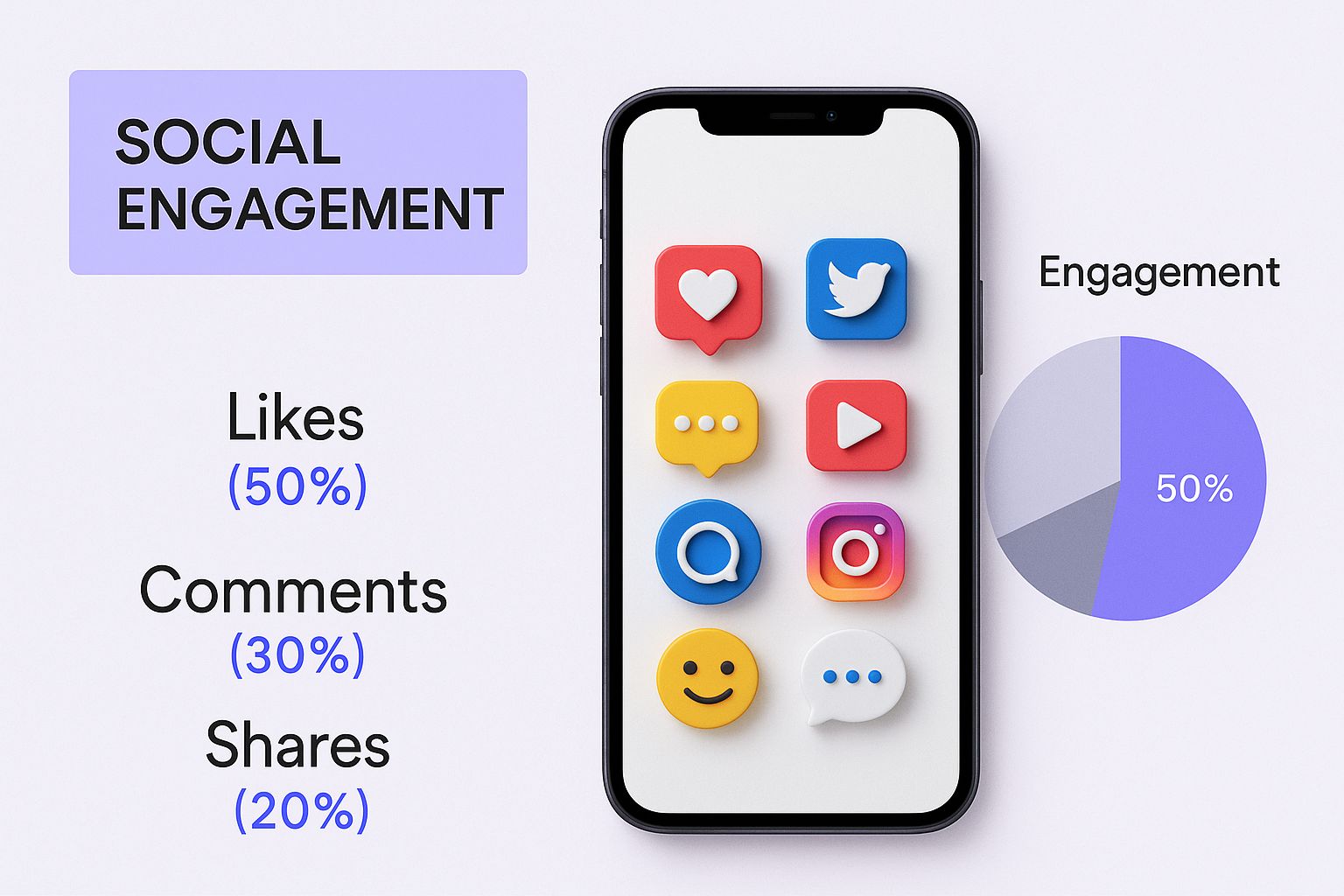
As the image shows, social media has become central to how we all connect and discover, making it a natural place to spend your first marketing dollars.
A classic startup mistake is spreading a small growth budget too thinly across half a dozen channels. It's far better to pick one channel you have a good hunch about, run focused tests, and learn from the results before you even think about expanding.
Phase 3: The Scale Budget
This is the fun part. This phase is all about pouring gasoline on the fire. By now, you’ve tested your channels, you know what it costs to acquire a customer, and you've found what works. The scale budget is for doubling down on your proven winners to kick growth into high gear.
This might mean seriously upping your ad spend, expanding to new platforms you’ve been eyeing, or investing more heavily in the type of content you know drives conversions.
The shift to digital is massive and undeniable. In fact, digital advertising's share of global ad investment hit a staggering 72.7% in 2024, with total spending more than doubling since just 2019. Much of this explosion is thanks to accessible self-service platforms—the very tools that are perfect for startups ready to scale efficiently. You can find more insights on these advertising trends to see how they open up opportunities for businesses just like yours.
Startup Marketing Budget Allocation Comparison
To help you think about where to put your money, here’s a quick comparison of two of the most popular digital marketing activities for startups. It shows what you can generally expect in terms of cost, how long it might take to see a return, and how easily you can ramp things up.
| Marketing Activity | Typical Monthly Cost (Low-End) | Time to ROI | Scalability |
|---|---|---|---|
| SEO & Content Marketing | $500 – $2,500+ | 6-12 months | High |
| Paid Ads (PPC) | $1,000 – $5,000+ | 1-3 months | Very High |
As you can see, paid ads offer faster results, while SEO is more of a long-term investment that builds a lasting asset. Neither is inherently "better"—it's all about which one aligns with your goals at your current stage.
By following this phased approach, your budget will grow and evolve right alongside your business, moving you smoothly from initial setup to sustainable, data-driven growth.
Measuring What Matters to Optimize Your Strategy
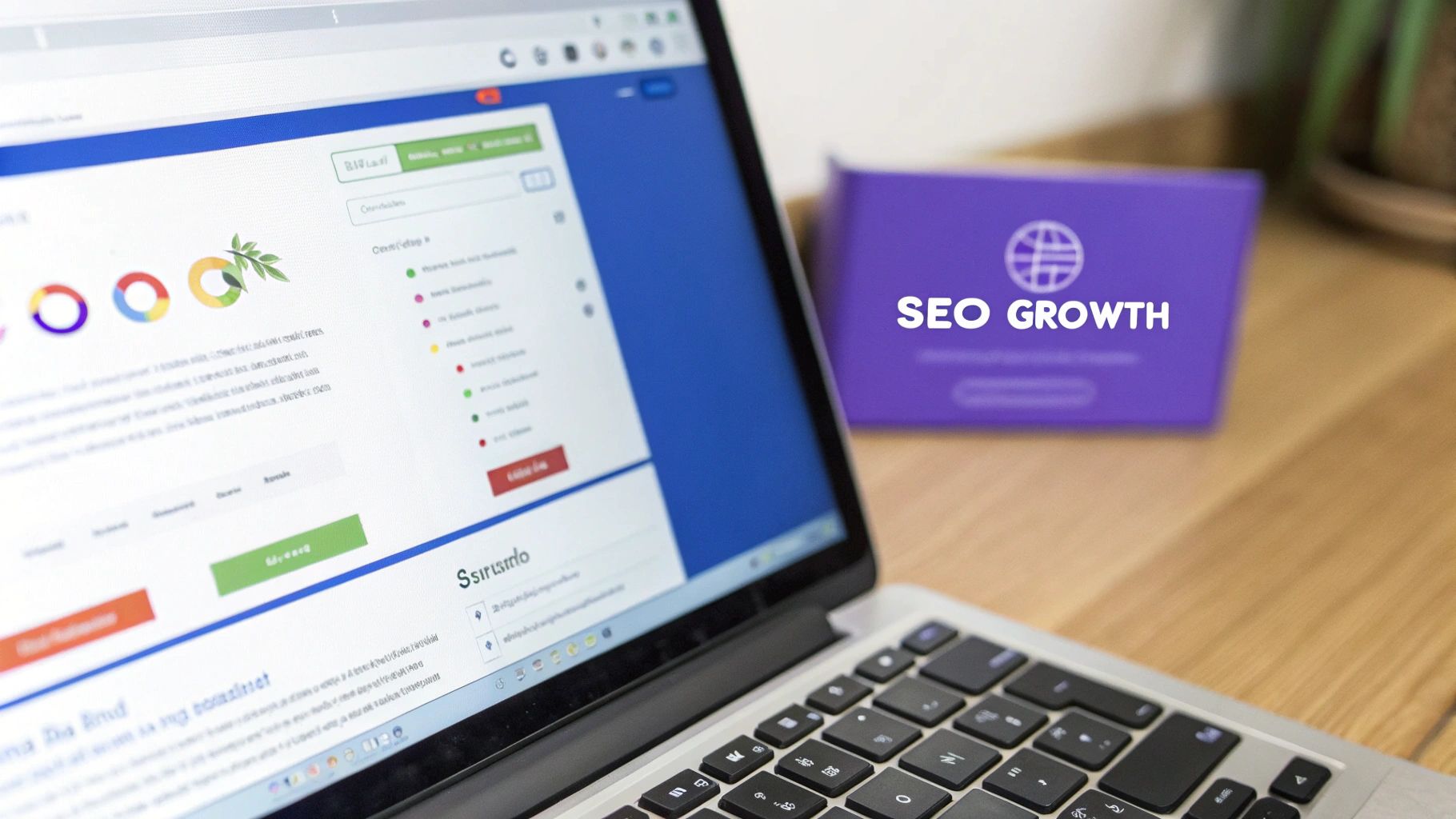
Getting your first few marketing campaigns out the door feels great. But the real work—the part that separates startups that thrive from those that just survive—starts with a simple question: "Is any of this actually working?"
In digital marketing, data is your secret weapon. It’s the honest feedback you need to stop guessing and start making smart, calculated decisions. Without it, you're flying blind, pouring your limited budget into things that feel right. With it, every dollar becomes an investment in real, measurable growth.
From Vanity Metrics to Actionable KPIs
It's tempting to get excited about numbers that look good on a report but don't actually move the needle for your business. We call these vanity metrics. A flood of new social media 'likes' or a spike in 'impressions' can be deceiving, giving you a false sense of progress while your core business goals remain unmet.
Smart startups quickly learn to ignore the noise and focus on Key Performance Indicators (KPIs). These are the metrics directly tied to your company's health—things like revenue, customer growth, and profitability. They tell you the true story.
Here are the essential KPIs you should be living and breathing:
- Customer Acquisition Cost (CAC): This is the total amount you spend on sales and marketing to land one new customer. It’s the price tag for growth.
- Customer Lifetime Value (LTV): This metric predicts the total revenue a single customer will generate for you over the entire time they do business with you. It shows you what each customer is truly worth.
- Conversion Rate: This is the percentage of people who take a specific action you want them to, whether it's signing up for a trial, downloading an ebook, or making a purchase. It shows how effective your marketing is at persuading people.
The real magic happens when you look at these KPIs together. For a sustainable business, the golden rule is that your LTV must be significantly higher than your CAC. A healthy benchmark to aim for is an LTV:CAC ratio of 3:1 or better. In simple terms, for every dollar you spend bringing a customer in, you should be getting at least three dollars back over their lifetime.
Setting Up Your Analytics Foundation
You don't need a massive, expensive software suite to get started. In fact, some of the most powerful tools are completely free. Your very first move should be to install Google Analytics 4 (GA4) on your website.
GA4 is the industry standard for a reason. It gives you a clear view of where your visitors come from, what they do on your site, and which actions they take. Setting it up is relatively simple, and it immediately starts gathering the essential data you'll need to make better decisions. To truly get a handle on your progress, you need to understand the key website metrics to track for growth and build a comprehensive dashboard.
Think of your digital marketing not as a one-and-done project, but as a continuous cycle: Implement → Measure → Learn → Optimize. Every campaign is an experiment that gives you the data to make the next one even better.
One of the quickest ways to improve your results without spending more money is by improving your conversion rate. For a deep dive into practical techniques, our guide on https://sprello.ai/blog/conversion-rate-optimization is a great resource. This constant process of testing and refining is the heart of great marketing—it’s how small, steady improvements lead to massive growth over time.
Your First 90 Days: A Step-by-Step Action Plan
Alright, theory is one thing, but making it happen is what actually grows your startup. Let's translate all those ideas into a concrete, 90-day action plan. This framework isn't about getting everything perfect overnight. It’s about building momentum, one deliberate step at a time, to give your marketing a strong, focused start.
Think of these first three months less like a sprint for sales and more like laying the foundation for a skyscraper. You have to get the groundwork right before you can build up. Each 30-day phase sets the stage for the next, creating a system you can repeat for consistent growth.
Month 1: The Foundation Phase (Days 1-30)
Your first month is all about building your home base online. Before you can throw a party, you need to build the house, get the power turned on, and make sure the doorbell works. This part isn't always glamorous, but it's absolutely critical for everything that comes next.
The main goal here is to set up your owned digital properties and get your measurement tools in place. This gives you control over your brand’s presence and ensures you can track every click and visit right from day one.
Your Month 1 Action Checklist:
- Set Up Your Digital HQ: Get your website and blog live. Make sure it looks great on a phone and loads fast—no one waits around for a slow site.
- Install Your Tracker: Integrate Google Analytics 4 right away. You want to capture data from your very first visitor.
- Claim Your Social Turf: Create profiles on the 2-3 social media platforms you identified earlier. Even if you don't plan to post immediately, grab your brand name before someone else does.
- Start Your Keyword List: Begin compiling a list of keywords and questions you think your ideal customers are typing into Google. This is your treasure map.
Month 2: The Activation Phase (Days 31-60)
With your foundation solid, it's time to flip the switch and see who’s out there. This month is all about activation—publishing your first pieces of content and running a small, targeted test campaign to see what gets a reaction.
The goal isn't huge numbers. It's about gathering real-world data. Think of it like testing different kinds of bait in a new fishing spot to see what the fish are biting.
Your budget in this phase is for learning, not just earning. The insights you get from one small, well-run campaign will be far more valuable than the initial ad spend.
Here’s how to get things moving:
- Publish Cornerstone Content: Based on your keyword research, write and publish 2-3 genuinely helpful pieces of content. Think of a detailed "how-to" guide or a comprehensive post that covers a major topic in your industry.
- Launch Your First Test Campaign: Dedicate a small, controlled budget (say, $100-$500) to a single paid channel. Use it to promote your best piece of content to a very specific slice of your audience.
- Start Your Email List: Add a simple email signup form to your website and within your blog posts. It’s never too early to start collecting emails from people who are interested in what you have to say.
Month 3: The Optimization Phase (Days 61-90)
The final stretch of your first 90 days is all about learning and refining your approach. You now have some initial data from your website and your first campaign, which means you can start making smarter decisions. This is where you'll start to feel the real power of digital marketing.
Your focus now shifts from simply doing things to analyzing what happened and making it better.
Your Month 3 Optimization Loop:
- Analyze the Results: Dive into Google Analytics and your ad platform’s dashboard. Which blog post got the most traffic? What ad copy had the best click-through rate? Be a detective.
- Double Down on What Works: Take what you learned and act on it. If one ad message clearly resonated, put more budget behind it. If a particular blog topic was a hit, write another post on a related subject.
- Test One New Thing: While you're busy reinforcing what works, introduce one new variable to test. This could be a different ad headline, a new landing page design, or promoting your content on a second social platform.
Following this 90-day plan creates a powerful cycle: build, test, learn, and repeat. By sticking to these steps, you’ll move beyond theory and start building a measurable marketing engine from the ground up.
Digital Marketing for Startups FAQ
Let's be honest, jumping into digital marketing as a startup founder can feel like you're trying to drink from a firehose. You’ve got questions, and that’s a good thing. We’ve pulled together some of the most common ones we hear to give you straight answers and help you get started on the right foot.
How Much Should a Startup Spend on Marketing?
There’s no single "right" answer here, but a solid rule of thumb for a new startup is to set aside 20-25% of your total budget for marketing. That might sound high, but remember, you're building a brand from scratch. You have to make some noise to get noticed.
A smarter way to think about it, though, is to work backward from your goals. Let's say you want to get your first 100 paying customers. If you figure out it costs you about $50 to acquire each customer (your Customer Acquisition Cost, or CAC), then you know you’ll need a $5,000 budget to hit that goal.
Start with a small, testable budget, track your results obsessively, and pour more money into what’s actually working.
The biggest mistake I see founders make is getting caught up in vanity metrics like social media likes and follower counts. Focus on what moves the needle: Customer Acquisition Cost (CAC), conversion rates, and real, actual revenue.
When Should You Hire an Agency vs. Build an In-House Team?
This is a classic "it depends" situation, but the choice really comes down to your current stage, cash flow, and how fast you need to move.
Building your own in-house team is a fantastic long-term play. You get people who live and breathe your product and have complete control over the strategy. The downside? It’s slow and expensive to hire, train, and manage the right people from day one.
Hiring a marketing agency, on the other hand, gives you instant access to a full team of experts. It’s often the best move for startups that need to test different channels and get results now without the overhead of salaries. You can always bring marketing in-house later once you've figured out what works and know exactly who you need to hire.
Ready to create high-performing video ads in minutes without the complexity? Sprello uses AI influencers to turn your existing assets into engaging, UGC-style videos for any platform. Start your free trial and scale your content today at https://sprello.ai.
